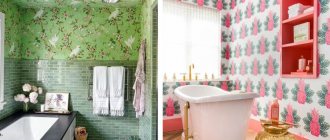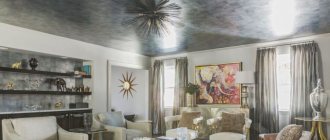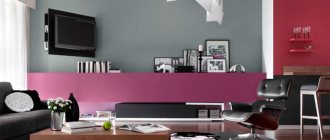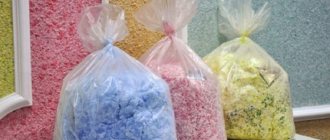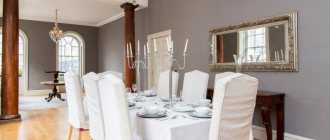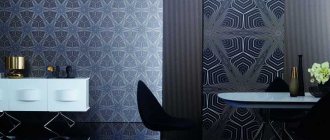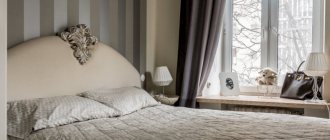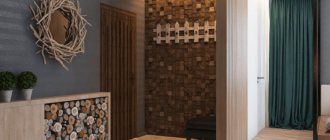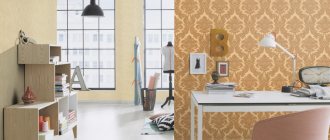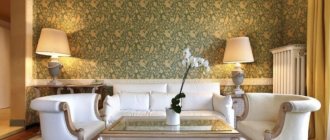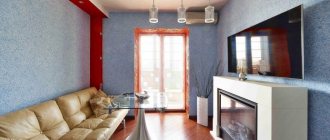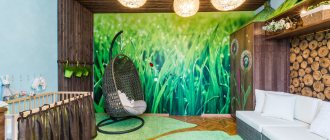09.10.2017
It is not surprising that when the question arises about renovating a room, the first thing everyone thinks about is the decoration of the walls. The variety of surface design technologies is amazing, but wallpaper remains the most popular and in demand. When choosing them, many indicators are considered. The most practical are washable wallpapers. There are several types of them, and the canvases differ in the quality of materials and rules of care.
Briefly about technology
The “washable” category includes a whole group of materials that differ in composition, price, performance characteristics and decorative appearance, but have common qualities - moisture resistance, wear resistance, strength, durability.
To understand which wallpaper is suitable in a particular case, you need to pay attention to the marking - an icon with the image of a “wave” and a “brush”:
- One wavy line indicates a low degree of moisture resistance of the fabric, which can only be washed with a wet cloth or sponge.
- The two “waves” can be rubbed vigorously, but avoid exposure to aggressive ingredients.
- Three “waves” on the marking indicate a particularly resistant material that can withstand cleaning with the use of saturated soap solutions and most cleaning products.
- If a “brush” is also drawn under the lone “wave,” then in addition to strong alkaline solutions, the wallpaper can also withstand the effects of hard bristles.
- Several wavy lines along with a “brush” indicate the most resistant to all types of impact, which will be difficult to damage even with intensive cleaning.
This is interesting: LED and neon window lighting: advantages (21 photos)
Features and benefits of washable wallpaper
Washable wallpaper is precisely different in that it can be washed and the top layer will not deteriorate.
Washable wallpaper in the kitchen interior
All types of rolled wallpaper have markings that you need to pay attention to when purchasing:
- And or one wave is washable wallpaper with a thin layer that cannot be completely wet, but can sometimes be wiped with a damp sponge, but not completely, but only in places of contamination.
- B (two waves) indicate that wallpaper can sometimes be washed with a damp sponge, but without using aggressive chemicals that can damage the surface film.
- Marking C is represented by thermal waves and means that such wallpaper can be “safely” washed using household detergents.
- D (wave and brush) indicates that the wallpaper is strong enough to withstand moisture. When cleaning, you can use a brush, but not a hard one.
- E (three waves and a brush) indicate the high strength of the wall finishing material, which can be washed quite often using a brush. It is almost impossible to damage such wallpaper.
- Marking F warns that wallpaper can only be cleaned dry and not wet under any circumstances.
Thus, it is clear that when purchasing, you should definitely look at the markings in order to understand which wallpapers can be washed with a brush, and which ones are not recommended to be wet at all.
Washable wallpaper is very popular because it has a large number of advantages:
- wide range and huge classification by color, size, texture, quality and type of wallpaper
- resistance to external damage extends the life of the material
- washable wallpaper made it possible to create original designs for all types of premises
- simple installation and dismantling, which even a beginner in the repair and construction business can handle
- affordable price for all segments of the population
Washable wallpaper has been popular among finishing materials for many years and is often used for the kitchen, hallway or other types of premises that require wet cleaning from time to time.
Kinds
Vinyl wallpaper is a two-layer covering on a paper or non-woven basis. The top layer is polyvinyl chloride, which mainly gives the wallpaper certain properties. Depending on the method of application, three types of vinyl coatings can be distinguished:
- Foamed vinyl - patterns are obtained by the method of thermal exposure and expansion of the pores of polyvinyl chloride. These wallpapers are very textured and voluminous.
- Hot stamping . There are three varieties of it: silk-screen printing (inconspicuous relief, the texture is achieved by refracting light on uneven surfaces), vinyl compact (embossing of foam material) and inhibitory (embossing is performed by applying special substances that do not allow the vinyl to foam).
Designs range from imitation silk to decorative plaster, brick and stone.
- Rubberized vinyl is distinguished by the presence of an additional layer. Washable wallpaper from it can be glued even in the bathroom. The choice of colors is not very diverse. Almost all coatings are non-uniform.
- Non-woven coverings are made of non-woven material based on cellulose. The texture is usually rough and is perfect for painting. The interlining is elastic and stretches well, but at the same time dense and durable. Such wallpaper is easy to paste. The adhesive composition is applied directly to the wall, and the sheets fit well on it.
- Acrylic wallpaper is also produced on the basis of paper or non-woven fabric. Acrylic is applied to the top layer, forming a pattern. These wallpapers are more environmentally friendly than vinyl, although they have a shorter service life.
- Fiberglass wallpaper is a modern roll washable material. They are made from fiberglass impregnated with special substances. They can also be painted.
- Metal wallpaper is another type of washable canvas. When making them, aluminum foil with a given ornament and shade is applied to a paper or non-woven base.
- Liquid coatings are a powder material that, in diluted form, is applied with a spatula to prepared walls. It consists of cellulose and various additives. At the last stage, the surface is coated with an acrylic varnish composition, which ensures moisture resistance.
- Fabric-based wallpaper has a structure made of a layer of paper or non-woven fabric and natural fabrics (cotton, silk, linen, velor). They create an unusual and stylish design in the room.
- Film wallpaper is a roll material made by applying a special hydrophobic film to a paper base. This is a budget finishing option with many colors, but there is no need to talk about any showiness or luxury.
- Cork materials are an interesting modern coating made from a paper or non-woven layer covered with cork veneer. Wax acts as a protective layer. This finish is completely natural and environmentally friendly.
Types of washable wallpaper
A large selection of types - comfort in the house, decoration of any room. There are 6 washable paper options in total.
Each is unique and has a different level of strength:
Non-woven
They consist of a substance - non-woven fabric.
The wallpapers themselves are divided into 2 categories:
- Actually non-woven, completely consisting of it.
- On a non-woven basis.
Wallpaper made from this material is durable and environmentally friendly. They do not change the humidity, and therefore the microclimate of the rooms. This happens due to the fact that this substance consists of cellulose, textile fibers, held together with a special glue.
You can purchase wallpaper with a ready-made pattern, or special ones for painting. These have a plain, white color. Non-woven paper for coloring makes it possible to approach the design side and decorate the room yourself.
Remember that when painting, the “breathing” of the walls will be worse. If the wallpaper has intended bulges, then when painted, its depth will become less, and therefore, you should not take it with a fuzzy or superficial 3D pattern.
Much attention should be paid to the glue and the variety of wallpaper layers. They are single-layer and multi-layer. If you plan to apply one color to another, then it is better to take the second option, since on single-layer ones, all layers are visible through.
If we talk about the disadvantages, then it is more expensive compared to regular ones.
Acrylic
Very useful around the house. Their surface consists of small holes that are impossible to notice. It is with their help that the wallpaper breathes, normalizes the air in the apartment, and prevents the appearance of fungus, mold and other harmful substances. Coating – acrylic spraying. The base is an analogue of foamed vinyl.
Main advantages:
- Absolutely environmentally friendly.
- Not afraid of mechanical impact.
- Care is required, but not whimsical.
Minuses:
- Small design choice.
- The service life is slightly less than that of vinyl.
- The number of colors is limited.
Vinyl - two-layer
Paper or non-woven fabric and polyvinyl chloride coating. If before they did not breathe, then thanks to developments, now they have breathing pores. But with their help moisture is retained. Pasting can be done both on walls and ceilings.
The store may offer the following varieties:
- Without embossing - foamed, high density.
- With hot stamping:
- compact vinyl, visually imitate heavy materials (bricks, stones, etc.);
- silk-screen printing, with a smooth variegated silk structure;
- heavy, resistant to mechanical stress, have visually leveled surfaces;
Pros:
- Light fastness.
- They do not require special care.
- They have high elasticity.
Glass wallpaper
They got their name because of the smooth fiber surface. The effect of tenderness and smoothness is achieved using modified starch impregnation.
The peculiarity of glass wallpaper lies in its appearance. All designs are geometric, be it a herringbone, a chessboard or just geometric shapes. In a damp room, their location is ideal, since they do not deform when exposed to high moisture.
Advantages:
- Resistant to damage.
- They look good painted in offices and public places.
- Do not contain allergic substances.
- The material is not only resistant to water and smoke, but also does not burn.
Flaw:
- Cold on contact.
Liquid
The composition has many options. You can take a closer look at the base, fibers, cellulose, silk and cotton threads, natural dyes or natural fungicides.
Positive characteristics:
- They can be applied not only to walls and ceilings, but also to more complex objects - batteries, pipes.
- A wide range of.
- With their help, there is warmth in the room.
- They help well in the form of sound insulation.
- Not harmful.
- Larger damage can be easily replaced.
- Irregularities are well hidden.
- Resistant to fires, drafts and frost.
- Does not require fussing with a sponge and wet wipes.
Negative sides:
- They are resistant to moisture only if the surface is coated with varnish.
Metal
They are made entirely of steel and other metals. Also, the composition may contain not only ordinary metallic substances, but also silver, gold, and bronze.
When creating, foil (aluminum) is applied to the first paper and porous layer. The surface is covered with a special paint that is resistant to current, and only then the design itself is applied using varnishes and electricity-insulating paint.
Metallic powder is used for finishing. This is such a long way to go for these seemingly simple wallpapers.
Advantages:
- Insulates electric current and listening objects.
- The material is not at all afraid of water.
- Excellent maintenance of a constant room temperature.
Minus:
- Constant ventilation of the room is required, since the wallpaper does not allow air to pass through and does not evaporate water. Accordingly, all vapors linger in the air. However, if you combine them with breathable wallpaper, the problem will quickly be solved.
Advantages and disadvantages
Advantages of washable wallpaper:
- Easy to care for. Any dirt can be easily removed with a damp cloth. It is possible to use household cleaning solutions, and on some types of wallpaper even brushes with coarse bristles.
- Huge range of colors. You can find an option to suit every taste, budget, and level of preparation for repair work.
- Can replace more expensive coatings. For example, in the kitchen, thick rubberized wallpaper will look great instead of ceramic tiles on the apron. And the ceiling and walls in the bathroom can be covered with film or vinyl wallpaper. But if you choose ceiling vinyl or cork wallpaper, then take into account the considerable weight of the canvases and the difficulty of such finishing.
- Long service life. Washable wallpaper is durable due to various additives and protective layers. Paintable wallpaper can last up to 30 years.
- The coatings do not fade in the sun and retain their original appearance for a long time.
The main disadvantage of washable coatings is that they are not environmentally friendly. Only some of them give walls the ability to breathe. Therefore, it is better not to use this type of finishing for children’s rooms and bedrooms. Wallpaper for painting is safe from an environmental point of view only when painted with suitable paint (for example, alkyd paint compositions contain harmful resins). Cork flooring is breathable, but has a very high price.
Gluing technology
We will try to briefly describe how to glue washable wallpaper in order to achieve the final desired result without much effort. The entire strip is coated well, including the joints. It is imperative to press the canvas tightly against the wall and expel the air with a roller to prevent bubbles from forming. The movement of the roller should be directed from the center of the canvas to its edges.
Thanks to the thick base of this wallpaper, it is possible to peel and stick it several times until you achieve the desired result. For an ideal appearance, you need to match the edges of the canvases end-to-end, then the seams will not be noticeable. But this same dense structure forces you to carefully consider the choice of suitable glue. For such materials, a special adhesive with a reinforced formula is intended. It is desirable that it has an antiseptic effect, with the addition of fungicidal substances.
Moisture-resistant canvases are usually heavier than regular ones, so when choosing glue for them, you need to take this feature into account
It is necessary to attach the strip to a surface previously treated with a primer, which will significantly save the consumption of adhesive liquid. Despite the fact that vinyl wallpaper most often has a non-woven base, both the wall and the canvas itself should be coated with glue.
This is interesting: Ottoman in the interior (19 photos): an island of comfort
Rules for gluing washable wallpaper
To properly hang washable wallpaper, you must follow a step-by-step process.
Preparing walls for gluing
Before gluing washable wallpaper, you must carefully prepare the surface. First of all, the old decor is removed:
- If you need to remove old wallpaper, it is recommended to first moisten it generously by wiping it with a wet cloth or spraying water from a spray bottle. After a short period of time, the glue will “limp” and the canvas can be removed very easily. Remains of paper and glue are removed with a spatula.
- Old paint is removed using special solutions; after treatment, the layer is peeled off with a spatula or scraper. The paint is also softened by firing with a gas torch, but when using this method, fire safety rules must be observed.
Then the surface is puttied and all irregularities are smoothed out. After leveling, the walls are treated with a special antifungal solution, of which there are a great variety on sale. The final stage of preparation is priming the base with a primer with a high degree of adhesion for maximum adhesion of the wallpaper to the wall.
Please note: the quality of preparation can be checked with a primitive test - a small strip of tape is glued to the primed surface and torn off with a sharp movement. If there are no fragments of plaster left on the tape, then the result can be considered positive.
Glue selection
When choosing an adhesive, you should take into account that washable wallpaper is much heavier than other types of wallpaper: the adhesive must exactly comply with the technical recommendations of the manufacturers; this information is indicated by the manufacturers on the packaging of the rolls. For vinyl wallpaper, glue of the “Super Vinyl” type is used, which ensures an easy process of combining the canvases due to good glide. Fiberglass and acrylic wallpapers are glued to special acrylic compounds, and for metallized wallpapers, dispersion adhesive with fungicidal additives is used.
Gluing process
We recommend reading: Calculating the amount of wallpaper
There are several rules for gluing washable wallpaper, if followed, the result will definitely be positive. Follow these guidelines:
- Gluing wallpaper is allowed only after the walls are completely dry.
- The sticker is applied in the direction from the windows.
- In order for the stripes to be positioned evenly, it is necessary to apply a starting vertical marking on the wall - it is most convenient to carry out this procedure using the good old plumb line.
- Washable wallpaper should be glued strictly using the “joint to joint” method - they are quite thick and when glued overlapping, the joint will be very noticeable.
- After the glue has infused and swelled, it is applied to the surfaces to be glued according to the instructions.
- The canvas is applied to the wall and smoothed with a soft sponge from the middle to the edges.
- Then, using a rubber roller, carefully remove air bubbles from under the wallpaper.
Important: when carrying out work, you must carefully ensure that the glue does not get on the outer surface. If such a problem does occur, it must be immediately washed with water and wiped with a dry soft cloth, otherwise, after drying, the glue stain will stand out against the surrounding background.
- During wallpapering and until it dries completely, you should ensure that there are no drafts in the room, otherwise the wallpaper to be pasted will come off the wall.
- Before carrying out repairs, it is advisable to dismantle the skirting boards and cover the wall to the floor. If this is problematic, then the lower edge of the strip should be adjusted to meet the baseboard.
Detailed video instructions for gluing vinyl wallpaper are given below:
Washable wallpaper should be cleaned of dirt according to the manufacturer's recommendations, which are indicated on the roll packaging - after all, different cleaning methods are allowed for each type of material. It is best to try to remove dirt using a dry method - with a brush or vacuum cleaner. If the attempt is unsuccessful, then it is better to wipe the surface with a damp, well-wrung out sponge or soft cloth. It is better to use neutral detergents that do not contain aggressive substances. It is not recommended to over-wet the material to avoid softening the glue and peeling the wallpaper.
Washable wallpaper is a modern, aesthetic, fairly durable material. If you follow the rules for pasting and further caring for them, rooms decorated with washable wallpaper will delight their owners for a long time with their ease of maintenance and stylish design.
( 87 votes, average: 4.80 out of 5)
How to make an apron in the kitchen: types of finishing materials and recommendations from experts
Roof waterproofing
Related Posts
Material overview
Types of washable trellises
In principle, the main characteristic of washable wallpaper is its ability to withstand periodic moistening and cleaning using brushes and other means.
At the same time, depending on the material used in the manufacture, trellises are divided into the following groups:
- Washable vinyl wallpaper for the kitchen is the most popular type . They are a film made of smooth, foamed or corrugated PVC, applied to a base of non-woven fabric or thick paper.
- The service life of such wallpaper for decoration is about 15 years . Today, manufacturers of almost all varieties of this material impregnate the base with fungicides and antiseptics, which minimizes the risk of damage to the finish by bacteria and fungi.
Note! Some models of vinyl trellises are characterized by the additional use of silk or synthetic threads fused into the vinyl coating. Such silk-screen printing does not in any way reduce the abrasion resistance of vinyl.
Photo of vinyl trellises with a kitchen-themed pattern
- Textile wallpaper can also be used to decorate rooms with high humidity . Since flax or cotton fibers themselves do not resist getting wet well, a Teflon coating is applied to the textile layer. By the way, it greatly facilitates the removal of contaminants from such wallpaper - dust, drops of grease, etc.
- Another type of washable trellis is non-woven . In terms of durability, they are somewhat inferior to vinyl, but are also quite suitable for kitchens. The impregnation of the fabric itself, as well as acrylic and latex paints, which are applied to walls already covered with wallpaper, are responsible for the water-repellent properties of this material.
- Washable, cheap wallpaper for the kitchen is a regular roll of paper with a printed pattern, impregnated with a special compound to protect it from getting wet . This type is the least reliable, since the impregnation rarely withstands intense exposure to brushes or household chemicals for more than several years. Then we have to carry out new repairs.
Kitchen with non-woven trellises
Advice! When purchasing materials of this type, you should carefully study the markings on the roll. As a rule, products marked with pictograms depicting two or three waves (meaning washability) and brushes (mechanical processing is allowed) are suitable for finishing kitchens.
Advantages and disadvantages
If we talk about the advantages, then washable wallpaper for the kitchen has the following advantages:
- Firstly, as the name suggests, this material can be cleaned of contaminants not only using the dry method. Teflon or vinyl coating resists moisture well, and in high-quality models it can even withstand treatment with a fairly hard brush and detergents.
- Secondly, this material itself is quite strong and durable. During use, the colors do not fade, and the texture of the relief surface remains as clear.
Note! Trellis with deep embossing require more frequent cleaning, but they also look more attractive.
- Thirdly, today you can find many models of similar materials. Selecting a pattern and color for any design is not difficult, and the price of the product can be quite affordable. Of course, there are also expensive products, for example, wallpaper with photo printing, but they are rather the exception.
Washable photo wallpaper for the kitchen is quite expensive, but looks great
- It is also worth noting the simplicity of finishing. Installing such a covering is not much more difficult than gluing ordinary trellises, and even a novice master can cope with it.
As for the shortcomings, most often they are a consequence of the vapor barrier properties of the material. Pasting walls with such wallpaper disrupts natural ventilation, and therefore a high humidity regime is established in the kitchen. There is only one way out of this situation - to provide regular ventilation to remove excess moisture.
Types of products
All washable wallpapers are often called vinyl. That the choice of products made from this material is huge, and the price is low. They serve for a long time and do not fade. Non-woven vinyl wallpaper is an excellent option for the bathroom and kitchen. These products come in several types: foam vinyl, flat, kitchen. Foamed vinyl is convenient because it does not require the walls to be prepared with special care. Flat imitates decorative coatings well - stone, fabric, etc. Kitchen vinyl is thick and dense and can even replace ceramic tiles.
Acrylic products are made from paper. Acrylic does not cover the canvas with a dense layer, so the wallpaper allows air to pass through, which is good for creating a microclimate. This wallpaper is strong and wear-resistant, the thickness of the front layer is 2 mm. This is less than vinyl wallpaper, so its service life is shorter. Good vapor permeability allows you to glue wallpaper in bedrooms and living rooms;
Glass wallpaper
Glass fiber wallpaper is based on glass threads. Fiberglass wallpaper is woven like fabric, it is vapor permeable, environmentally friendly and durable. They do not support fire, are painted and can even be used to strengthen walls.
Metal wallpaper
They are made using aluminum foil. They can be embossed, patterned, or painted. These wallpapers were originally created to protect people from electromagnetic radiation. They are durable, resistant to sunlight, muffle extraneous sounds, are not affected by water, and are easy to maintain and clean. The disadvantages of metal wallpaper include their high cost and the fact that they do not breathe. The surface of the wallpaper is easily scratched. Before applying the sticker, the surface must be well leveled.
Where are they used?
Washable wallpaper is beneficial to use in the bathroom. They can easily replace tiles or wall panels, and a wide selection of colors will make it easier to create a decor.
The kitchen is also a great place to use washable coatings. Grease and soot, as well as splashes from cooking food, can be easily cleaned from such surfaces, while ordinary wallpaper would have to be changed frequently and especially taken care of. The only peculiarity of the selection of material is to choose one that does not absorb odors.
ceilings with roll materials that can be wiped or washed. Ceiling paint requires a smooth, prepared surface, but some defects can be corrected with wallpaper. And dust and dirt that accumulate on the material should be wiped with a damp cloth or special mops.
It is better to give preference to wallpaper with shallow relief so that dust does not get deep into the pattern.
In the hallway, wallpaper will save the walls from street dirt. Children's transport, boots, and umbrellas carry moisture and caustic chemicals from snow from the street into the house. Washable coatings will be better preserved and will not lose their appearance under such exposure.
Office spaces are another option where moisture-resistant materials will come in handy. Paintable wallpaper will be the best decorative element. They are easy to clean and change colors if desired. Savings on repairs are obvious.
Permissible intensity of wet cleaning
What washing method is suitable for different types of wallpaper? Each roll has a standard marking that states the following:
- One wavy line indicates that you can use a wrung out soft sponge or cloth.
- Two waves one below the other - you can use mild detergents.
- Three waves – it is permissible to use strong detergents.
- One wave and brush - you can scrub with a brush and use alkaline detergents.
- Three waves and a brush are especially resistant to abrasion and aggressive environments; they can be washed and cleaned in any way.
Standard markings on wallpaper
Marking of washable wallpaper
- One wavy line – moisture-resistant wallpaper. They are not suitable for washing with a damp sponge and detergent. You can only remove the remaining glue when gluing with a cloth well wrung out of the water.
- Two wavy lines – washable wallpaper. They are more resistant to moisture, can be wiped with a wet sponge and a non-aggressive cleaning agent; small dirt, dust, and fresh stains can be easily removed from them.
- Three wavy lines - super washable wallpaper. When cleaning, you can use any soap solutions.
- One wave plus a brush – clean-resistant wallpaper. Can be washed with a brush, sponge, vacuum cleaner with any cleaning product.
- Three waves plus a brush - super-resistant wallpaper. They are the most resistant to moisture, brushing and abrasion.
What types are there?
Now you need to consider the types of wallpaper directly. They can be represented by the following models: vinyl, acrylic, glass wallpaper, metal coatings, cork wallpaper with a wax coating. All these types have their own characteristics and properties during operation. Below we will consider each type of washable wallpaper separately.
Vinyl
This type of washable coating is the most widespread and popular, due to its fairly low cost and wide range of choice. This model is not subject to fading from sunlight.
In turn, vinyl wallpaper can be divided into subtypes, depending on the methods of their production:
- Foamed vinyl sheets are quite voluminous, but at the same time very light. They do not require special preparation of the wall surface before gluing them. It is very convenient to use such canvases to hide some defects in the wall.
- Vinyl flat wallpaper is a fairly durable and dense material. Such wallpaper is produced using the hot stamping method. Typically, flat vinyl is produced to imitate a stone surface.
- Kitchen vinyl. As the name suggests, this material is very convenient for finishing walls in kitchens. These coatings are quite dense and thick, and they are produced using rubberized vinyl, which makes their surface very resistant to moisture. Such wallpaper can be either smooth or embossed.
Acrylic
From the name it is obvious that the production of such wallpaper uses acrylic applied to a paper base. Thanks to this layer, the material is resistant to moisture and easy to clean from dirt. It is worth noting that the material of these coatings has good air permeability. It is not recommended to wash such wallpaper using various detergents.
It is best to use a damp sponge when cleaning such wallpaper.
Non-woven
If vinyl sheets are chosen for a damp room, such as a bathroom or kitchen, then you should choose wallpaper that contains non-woven material. Non-woven coverings are very resistant to high humidity. The service life of this material is approximately 20 years.
Liquid
The main advantage of this model is environmental friendliness. No active chemicals are added during their production. Initially, such wallpaper is a dry powder and when applied to the wall, it must be thoroughly mixed with water. It is recommended to mix by hand.
This material should be applied to the wall in a thin layer to avoid unevenness. No special preparation of walls is required for applying the liquid composition.
Other types:
- Fabric. This model is quite exclusive and is rarely used. For its production, a textile layer and a paper base are used.
- Film. This type of material is made by applying polyvinyl chloride mass to a paper base. This layer makes the surface moisture resistant.
- Glass wallpaper. The material of this model is based on glass threads, which makes the canvas incredibly strong, non-flammable, wear-resistant and durable. Their service life is more than 20 years. It is worth noting that this coating can be painted independently in any suitable color. It is advisable to use latex or acrylic paint.
- Metal wallpaper. In the manufacture of this type of coating, a paper base and aluminum foil are used. These coatings have a wide range of advantages: they are more durable than all other types, do not require wall preparation before gluing, increase the level of sound insulation, are incredibly resistant to high humidity and are very easy to clean.
- Cork wallpaper with wax coating. This model is the most natural and clean for covering walls, since this wallpaper is made from the bark of cork trees. A layer of wax on top of the base provides this type with protection from moisture. But it is not recommended to clean them with household chemicals.
- Ceiling. This model has a lower cost compared to stretch ceilings and looks quite aesthetically pleasing. This material does not require careful surface preparation.
When gluing washable wallpaper, you need to take into account some features:
- When gluing washable surfaces, special attention should be paid to the glue that will hold the wallpaper. This adhesive should have a stronger effect than for conventional paper surfaces. Each type of wallpaper has its own glue. For metal-coated surfaces, a dispersion adhesive containing a fungicide is usually used.
- When gluing, special attention should be paid to the seams so that during use and cleaning, the edges of the wallpaper do not move away from the wall if moisture penetrates under the seams. If there is a gap between the seams, the strips become wet and lose their external advantages.
- You should not wash the surface too often, because frequent cleaning will be harmful for any coating.
Types of washable wallpaper for the kitchen
Kitchen wallpaper is divided into several types, depending on the material from which it is made.
Among them:
- acrylic;
- non-woven;
- glass wallpaper;
- vinyl;
- metal;
- liquid.
Acrylic and non-woven
This multi-layer coating with inserts made of special foam material has a very interesting original design. It is complemented by three-dimensional drawings, so it becomes not just an element of decoration, but a real decoration of the room .
Of course, it can be washed, but due to these features, this must be done with extreme caution. You should not use any aggressive detergents, much less hard brushes. This surface should be cleaned with a soft damp cloth or sponge.
Non-woven wallpaper is one of the most popular materials among users for decorating walls in the kitchen. integrity and attractive appearance for a long time Buyers will also be pleased with their price.
Among several varieties of non-woven coverings, there are also those designed specifically for painting. Experts recommend covering them with one layer of special washable paint.
Glass wallpaper
This type of wallpaper is perfect for decorating the kitchen. They are completely made from environmentally friendly natural materials. Thanks to this coating, the owners will be able to hide various irregularities, cracks and other imperfections in the walls. And besides, you don’t have to worry about it breaking.
The special material from which the wallpaper is made is waterproof and also prevents the spread of various microorganisms. They can be washed frequently and repainted as many times as necessary (up to 10). Even after washing and painting, the original structure of the material is completely preserved. True, their price today is quite high.
Vinyl
Vinyl washable wallpaper for the kitchen can easily be called the most practical. They can be washed with rags, sponges, brushes, without fear for the safety of the design. After all, it is hidden under a durable transparent film.
They can be universal or designed directly for the kitchen. It is the latter that are the most persistent . They can also be used to decorate other high-load rooms. Don’t forget, the deeper the pattern on the wallpaper, the harder it will be to remove various contaminants from it. Therefore, for the kitchen it is best to purchase options with a flatter, simpler pattern. The price of such wallpaper can be very different, it all depends on the catalog presented by the store.
Metal
Today very few people are familiar with metallic wallpaper. They are a special porous thick paper covered with a layer of aluminum foil, paint, and some kind of pattern or design. Their most expensive options can be hand-painted and complemented with silver or gold plating. The price of such goods is sometimes very high.
True, such material can only be placed on a perfectly flat wall. The wallpaper in question can be washed with a soft, damp cloth or sponge.
Liquid
This unusual material is offered to customers in the form of a special powder. It may also contain silk fibers, glitter, mineral chips, cellulose and other additional ingredients necessary for beauty and strength . Before applying to the wall, the powder is diluted with water. They can only be used in the kitchen after being coated with a special protective varnish.
If any area of the surface becomes dirty, you can simply wash it off and then apply a new layer of liquid wallpaper to that area.
Color spectrum
White
White color has many advantages. It goes well with any shades, suits any design style, and most importantly visually makes the kitchen space larger. White can be taken as the main color or used as an additional color, combined with bright colors.
Greens
Green color has many shades, from bright young greenery to dark olive, which, by the way, is more suitable for decorating a spacious and well-lit kitchen.
The chosen shade should reflect the style of the kitchen, for example, rich colors are suitable for a modern style, a calm and muted green tone corresponds to a classic one.
The photo shows a bright kitchen in a modern style. The finishing is done in a light green shade.
Beige
A classic and universal shade will be a win-win option for decorating a kitchen. The beige tone can be combined with many shades; you can add bright colors to the interior in the form of a pattern on the wallpaper or through the color of the headset.
Black
A bold black tone should be used with caution in kitchen decoration. It is suitable for bright open spaces. Black can also be used as a secondary color, for example, in a pattern on washable wallpaper.
Yellow spots on wallpaper after gluing
Some people experience unpleasant consequences after wallpapering. What to do if yellow or dark spots appear.
Most often, yellow spots on the walls mean a poor-quality adhesive composition.
When hanging wallpaper, it is important to pay attention to many factors.
What affects the appearance of yellow spots:
- Incorrectly treated surface;
- Bad glue;
- Poor quality wallpaper.
Some claim that yellow spots may fade over time. They cannot be washed. You can only remove it by gluing new wallpaper.
Example of use instead of an apron
Washing wallpaper can also be used to finish the apron area. To do this, you should choose a durable material that interacts well with moisture. Fiberglass, vinyl and paintable wallpaper would be a good option. It is better to cover coatings with poorer interaction with water with protective glass.
The photo shows an open kitchen in a modern style. The apron area is protected by transparent glass.
Using styles
The use of different styles to decorate the kitchen interior allows you to make it unique, original, and most importantly - cozy. The style of minimalism and hi-tech is a solid color, abstract designs, imitation stone, brickwork or metal.
The classic style is best presented in the kitchen in the form of a cage, floral ornament, fabric pattern or photo panel. As well as ancient streets in the form of frescoes and paintings by famous artists. Provence and country represent light-colored finishes with floral patterns.
Image of vegetables, flower bouquets, still lifes. The texture of roughly planed boards, plaster, matting. All this goes well with light furniture.
Options and examples in the interior
Some recommendations for using wallpaper in interior design:
- If you plan to glue different models of wallpaper when renovating a room, then you need to select models of the same thickness.
- Bright colors are best combined with soft, pastel or beige tones.
- It is necessary to level the surface of the walls before gluing.
- A modern and creative move is to highlight one wall in the room using original paintings. Such a wall should have a bright and light color, and it is advisable to give all other walls neutral and monochromatic colors.
- In almost any furniture store, the seller can provide you with a catalog of products and examples of original wall designs.
- If you are not sure about the correct choice of wallpaper color, then you can buy “test” rolls of different models and see at home which option suits the room better.
- Having purchased textured wallpaper, you can paint it in any color of your choice, since this type of coating is specially made colorless for further painting.
- Photo wallpapers depicting a metropolis or landscape will help visually enlarge the room.
- If the room has a low ceiling, then designers advise using wall coverings with vertical stripes, and for a narrow room or corridor - with horizontal ones.
For more information about washable wallpaper, see the following video.
Proper care and washing
Even washable wallpaper coverings have care rules, following which you can extend the life of the wallpaper and maintain its original appearance.
- When cleaning, use a soft cloth or sponge, avoiding hard brushes.
- It is better to use a soap solution as a cleaning liquid, if the label allows it.
- Before carrying out wet cleaning for the first time, it is worth doing this in an inconspicuous area to check the reaction of the coating.
- Wet cleaning should be done as needed. Even washable coatings do not like too frequent contact with water.
Caring for washable wallpaper: cleaning stages
Before you start cleaning, you need to make sure that the wallpaper is actually washable.
Wallpaper with foil in the interior
The cleaning process occurs in several stages that must be followed to achieve a positive result:
- The first step is dry cleaning. Dust can be removed with a dry sponge or vacuumed. You also need to get rid of cobwebs. If you skip this step, then when it comes into contact with water, the dust will turn into a dirty stain on the wallpaper, which will be much more difficult to wash.
- Preparing for cleaning. You need to prepare a wallpaper cleaning solution in advance. It is important to take into account the labeling. If the wallpaper requires careful cleaning, then you can get by with a simple sponge dipped in warm, clean water. If the wallpaper is class C and higher, then you can use a soap solution. Under no circumstances should you use abrasive agents, as they will damage the surface layer of the wallpaper. It is best to dilute dishwashing detergent with water if you need to get rid of greasy stains, or liquid powder to freshen the walls.
- The main stage is washing. To do this, it is better to use a soft sponge or microfiber cloth, which will not damage the surface of the wallpaper. There is no need to wet it too much and before contacting the wall, the sponge should be squeezed out well. After “washing” it is recommended to wipe the wallpaper with a dry cloth.
Advice: if possible, avoid joints so as not to provoke peeling and swelling of the material.
